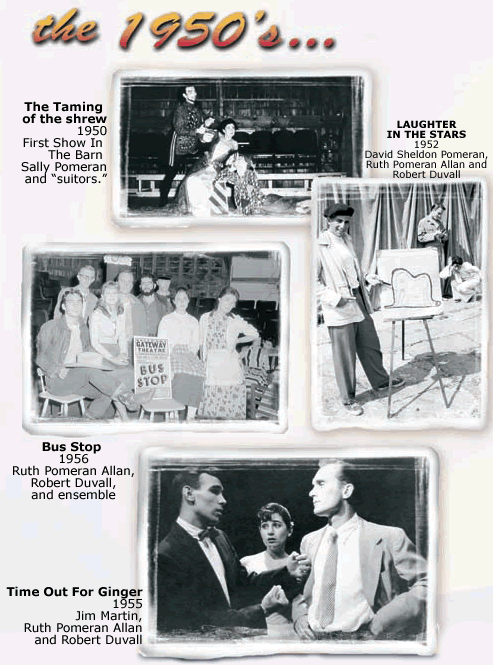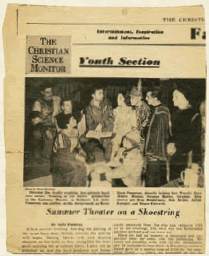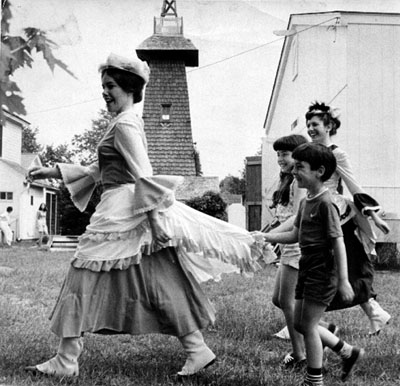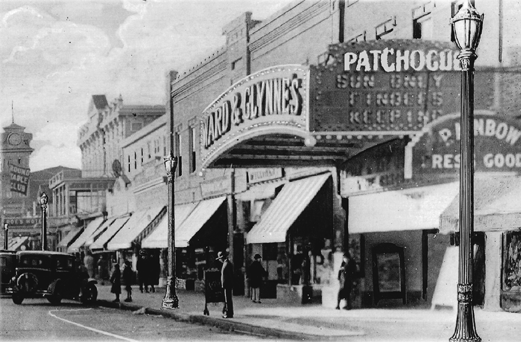Ruth B Shannon Center for the Performing Arts White Coat
"The idea was born when a small group of us, deploring the commercial stage, realized the need to spread good theater to pocket-size towns. There seemed present the demand to decentralize the theater, and in so doing provide the starved movie-fed audience with a quality of product above the boilerplate run-of-the-manufactory stock play.
We had three willing people and an empty befouled with which to start - why not effort? With this incentive, we proceeded."
— Emerge Pomeran, "Summertime Theater on a Shoestring," The Christian Science Monitor, 1952
Humble Ancestry (1941-1950)
In 1941, Harry C. Pomeran bought a lxx-acre farm in Bellport with intentions of starting a hotel. The property was congenital in 1827 for Charles Osborn and purchased in 1884 past J. L. B. Mott. Mott hired Stanford White to design a new wing for the Mansion Business firm. Harry and his married woman Libby converted the property into a resort hotel for Christian Scientists spending the summer on Long Island. Their three children Emerge, David and Ruth planted vegetables, washed dishes, waited tables, and milked Daisy, the family cow. In addition to Daisy, the property housed two hundred chickens as well equally hay, corn, and other farm essentials. The windmill pumped the family's water from a deep artesian well.
The Pomeran children entertained the guests by singing, performing skits and puppet shows and playing the piano. Local residents began lining up to see the performances, and Harry decided to make a small investment. Echoing Judy Garland and Mickey Rooney, the family thought, "Let's put on a bear witness!" In 1950, Daisy was evicted from the befouled to brand manner for a production of The Taming of the Shrew, and the Gateway Playhouse had begun.

A Theatre is Born (1950-1961)
 |
The Taming of the Shrew was a resounding success, and audiences flocked to see subsequent productions. Oldest sister Sally, at present finishing up college, devoted her senior thesis to designing an arena stage in the family barn with haylofts equally balconies on each side and dressing rooms in the stalls. Within a few short years, Emerge Pomeran (now Sally Harris) had transformed the Gateway Hotel into a fully-functional professional theatre.
At this time, the Gateway presented a diverse body of work from classics like Shakespeare and Moliere to contemporary works from Christopher Frye, Tennessee Williams, and William Inge. "We envisioned summertime stock hither and planned to move into a New York theatre in the wintertime," David Pomeran said. They never moved to New York, but a few years after, in a letter from Eleanor Roosevelt, the Gateway was named the "official international theatre of the United Nations." What started as a family theatre on the "Straw-Lid Trail" was rapidly becoming a professional theatre with a serious pedigree. Indeed, a number of large names cut their teeth on the stage at the early Gateway Playhouse. Factor Hackman, Ulu Grossbard, Michael Gazzo, Ken Howard and Julia Migenes-Johnson all worked with the fledgling theatre company.
Indeed, one of Ruth (Pomeran) Allan's fondest memories of the early days is the night in 1955 when Robert Duvall missed a very important cue in John Willard's 1922 thriller, The Cat and the Canary. Duvall, who was playing the villain, Charles Wilder, was meant to announced and choke another histrion to death. Realizing Duvall wasn't coming, the unfortunate costar improvised a brilliant solution. He turned away from the audience, moved upstage, and put his hands around his own neck to arrive announced as though Duvall had done the job by sticking his hands through the drapery.
From the very starting time, educating the next generation of theatre artists was a focus of Gateway's efforts. For the first x years, students were the chief performers, directors, and technicians. Apprentices lived on property for the summer, and they took classes in the morning time, rehearsed and built in the afternoon, and put on shows in the evening. "Learning past doing," has always been the motto, and to this day, interns come to Bellport to learn by making theatre at the Gateway.

Looking dorsum to how we began. An article reprinted from THE CHRISTIAN Scientific discipline MONITOR, written in 1951, describes the forward thinking and initial inspiration of Emerge Pomeran Harris, who, along with her two siblings, founded the Gateway Playhouse. Emerge, David and Ruth Pomeran Allan'southward vision and commitment to theater that would "not only entertain, but as a medium for world understanding" has propelled the Gateway Playhouse all these years. Like their talented family predecessors, Paul Allan, Ruth'due south Son and his sister Robin, go along the legacy to this twenty-four hours.
From Summertime Stock to Professional Theatre (1962-1970)
David and his father, Harry, were at the helm of the Gateway, by then known throughout the country as Long Island's leading Summer Stock Theatre and Training Center. In 1961, the theatre was selected equally a Columbia Pictures talent subcontract. Casting Director Joyce Selznick sent young upwards-and-comers to the Gateway to gain acting experience, and the theatre'southward productions provided opportunities for Due east Coast talent to be seen past West Coast producers and casting directors.
In 1962, the always-increasing demand for professional person product values led to the construction of the Main Stage Theatre. Professionals came from New York to run the Main Stage season, while the original Befouled Theatre was used for student productions and smaller second stage plays and musicals. A few talented apprentices took on featured and chorus positions on the main stage every bit office of their grooming, simply most focused on Barn Theatre efforts. All the scenery and costumes for the productions were congenital on the Gateway grounds, and dormitory facilities housed as many as 60 pupil apprentices during the summer months.
Throughout the threescore's, the Gateway produced as many as 16 productions a flavor, including a serial of children's shows. Such full schedules required 2 plays in production, ii in rehearsal and at least ane in the audition process at any moment. Apprentices and professionals akin never lacked for work.
Gateway's Second Generation (1970-1980)
In the 1970's, the novelty and popularity of summer-stock began to wane. Seasons tightened from the 12-16 sixteen to iv- half dozen productions every bit the Gateway founds its niche in full-scale musical productions. Ruth (Pomeran) Allan and her husband Stan took over every bit producers. The Gateway audiences continued to grow and included subscribers from all over the Island. The Allans, forth with their children Robin Joy and Paul, oversaw all technical and artistic aspects of the business concern and continued the training programs. Paul gravitated towards the technical terminate of the theater including carpentry, electrical and sound engineering, while Robin spent her time performing on the Chief Stage and writing, teaching and directing in Befouled Theatre.
In the 70's the training centre expanded a lot. Immature people who took role in the programs came to Gateway from all over the United States during the summertime months as workshop students, apprentices and Actors in Training (A.I.T.s). Their training encompassed morning classes, afternoon rehearsals and evening performances. The faculty, directors, counselors and administrative staff united to give inspirational guidance to immature actors.
A 3rd Generation of Producers (1980-1990)

"My kids were born in a body," Ruth Allen remembers fondly. Robin had her stage debut at 16 months, and Paul was always working backside the scenes. Paul remembers 1 night—well technically ane very early on forenoon—when Ruth was looking for her 12-yr-old son who ought to have been in bed in the wee hours of the morning. She came into the theater, he recalls, and asked "sort of anxiously, 'Where'southward Paulie?' - 'He'south upwards there on the scaffold. See him up at that place with the socket wrench?' someone on the coiffure said, pointing way upward towards the lights. Well, that did it. Mom ordered me down and dragged me off to bed while everyone was hollering, 'Only we need Paulie!'"
It'due south no surprise, then, that when Ruth embarked on a new career every bit a Christian Science practitioner and lecturer and Stanley was elected to role as Brookhaven Town Clerk, Robin and Paul stepped in to run the family unit business. The siblings were co-producers in the early 1980's, but Robin, pursuing an acting career, joined a National Tour of Godspell and later moved to Los Angeles to become a casting director. Her credits include: When Harry Met Sally, Parenthood, Ghost, and the remake of Lord Of The Flies. Stage Manager John Hodge filled her identify to become the Associate Producer with Paul for the residual of the decade.
The eighty'due south too saw vast improvements in the Gateway's facilities. Computerized lighting systems were added, the wing loft completely re-rigged, and a state-of-the-art sound system installed. Meanwhile, onstage, the Gateway hit its step, expanding offerings from 4 plays early in the decade to 6 or vii in the latter half.
Gateway on Bout (1990-2000)
"People wanted to know if they could hire our costumes or buy our sets, then nosotros decided to transport out the whole prove instead," John recalls. And send out the evidence they did. The touring company John and Paul began in the 90's sent shows to 25 U.S. cities every bit well equally countries around the earth. The Gateway's production of Andrew Lloyd Weber's Song and Dance enjoyed a 25-metropolis national tour, and their version of Rodgers and Hammerstein's The Audio of Music visited countries in the Far East including Malaysia, Singapore and—in a outset for American musicals—South Korea. Other Tours produced internationally included Annihilation Goes, South Pacific, Camelot, and A Chorus Line.
Standing the decade's theme of expansion, Gateway took over the 650-seat Candlewood Playhouse in New Fairfield, Connecticut, in 1993. The start production at the new theatre was the bear witness-biz classic, A Chorus Line. For the next five years, Gateway sends its shows to Connecticut. The Candlewood Playhouse productions received critical acclaim including many Connecticut Critics Circle Awards. In 1997, Paul Allan consulted on the renovation and restoration of Patchogue's derelict 1923 vaudeville house and motion picture theater, which reopened as The Patchogue Theatre For The Performing Arts. The Gateway discontinued productions in Connecticut in favor of expanding its local audition base to Patchogue. Gateway's 1998 production of Nutcracker On Ice was the first performance in the newly-renovated theatre, and for the adjacent two years, Paul and John managed the Patchogue Theatre along with Gateway Playhouse.
Growing Pains (2000-2010)
In 2003, Robin became the Artistic Director at Gateway, rejoining Paul at the theatre's captain. Under their leadership, show quality reached an best high. Indeed, Broadway-Quotient musicals were the story of the oughts at the Gateway. Ever-improving production values and the theatre's growing reputation for excellence began drawing in Broadway stars. For example, the record-breaking 2003 production of Miss Saigon that took Long Island by tempest starred Broadway performers Raul Aranas, Kingsley Leggs, and Alex lee Tano, all reprising their roles for Gateway. The Chief Phase also connected its history of debuting the side by side generation of Broadway stars every bit well with performers including Elizabeth Stanley, Kendra Kassebaum and John Lloyd Young actualization in Gateway productions.

Throughout the decade, Gateway presented four shows at the Principal Stage Theatre and two in Patchogue in improver to hosting both a Children's Theater and a Vacation Flavor at the two venues. The Prepare Rental Division and Acting School enjoyed much success. Gateway sets establish their manner across the country to peer theaters and Universities, and the Interim School Partition boasted several of their very talented alumni actualization in network television serial and commercials as well as on Broadway.
Despite all these successes, the Gateway or the Interim School were not allowed to the economical downturn that so effected arts organizations across America. Past the end of the decade, the organizations were experiencing extreme artistic success and nagging financial difficulties in almost equal measures.
A New Chapter (2011-present)
In 2011, Paul and Robin Allan made the difficult determination to reinvent the family business, combining the Gateway Playhouse and the Acting School to form the not-profit organization, the Performing Arts Heart of Suffolk Canton. As we brand the transition from commercial family unit business concern to non-profit regional theatre, nosotros are finding new opportunities to appoint with our audience, building relationship with other area organizations, and reevaluating our creative priorities. It is an heady and challenging new chapter in our history, a chapter we invite yous to share with u.s.a..
pedersonminve1998.blogspot.com
Source: https://www.gatewayplayhouse.com/online/article/history
0 Response to "Ruth B Shannon Center for the Performing Arts White Coat"
Post a Comment